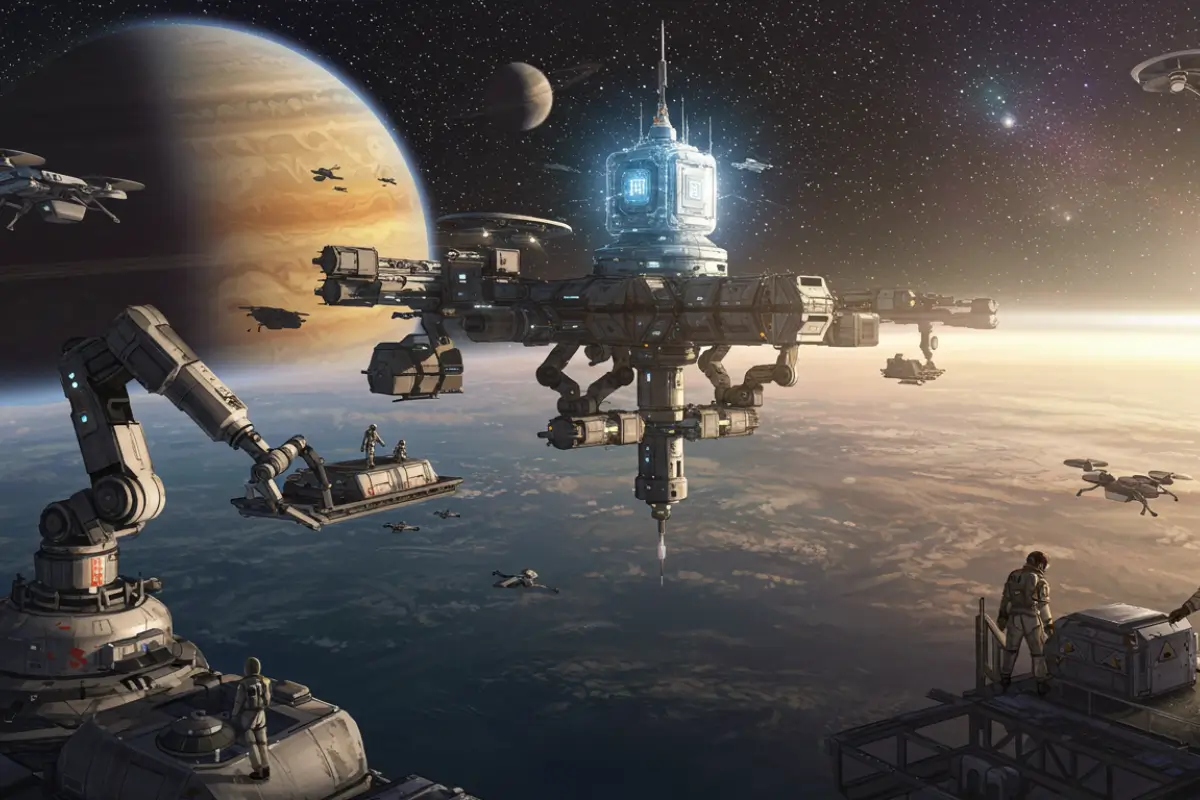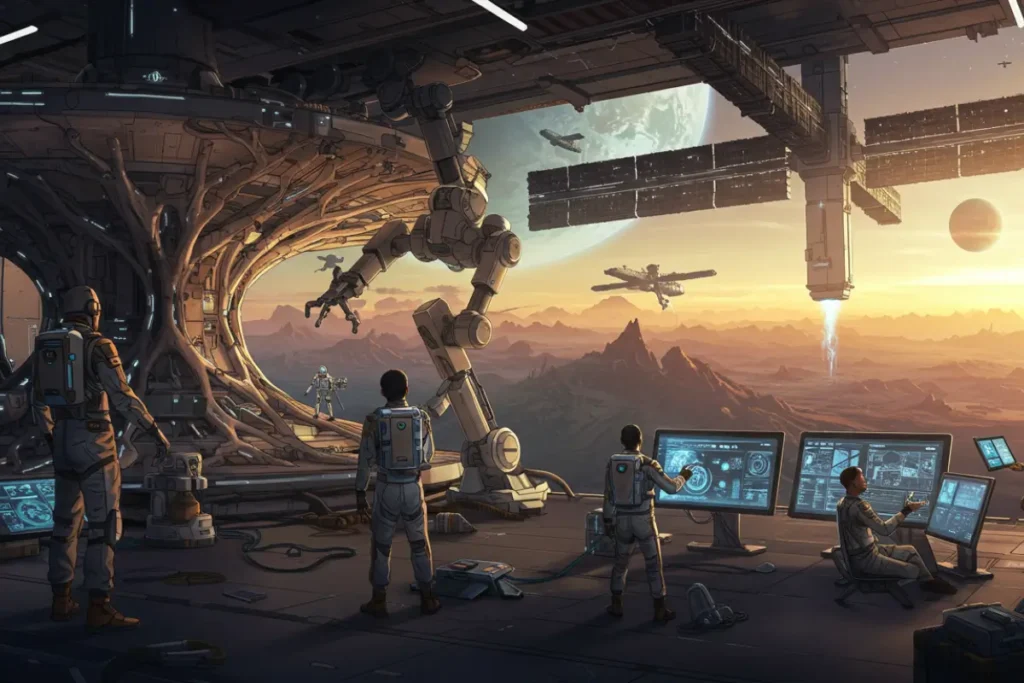The Role of AI in Space Colonization
- April 17, 2025
- 0
The Role of AI in Space Colonization Have you ever wondered what life might look like on Mars or beyond? 🌌 I’ve always been fascinated by the possibilities
The Role of AI in Space Colonization Have you ever wondered what life might look like on Mars or beyond? 🌌 I’ve always been fascinated by the possibilities

Have you ever wondered what life might look like on Mars or beyond? 🌌 I’ve always been fascinated by the possibilities of space colonization, but one thing is clear:
Without Artificial Intelligence (AI), this dream would be nearly impossible. As someone who loves futuristic technology and the idea of pushing human limits, I believe AI isn’t just helpful in this mission—it’s essential.
In this article, I’ll take you on a journey through how AI is being used to support life on other planets, build infrastructures in hostile environments, and even protect human life in space.
So relax, and let’s explore this cosmic adventure together!

Thinking about life on Mars is exciting, right? But living on another planet isn’t just about hopping on a rocket and setting up camp.
It’s about solving thousands of problems that we don’t even deal with on Earth. That’s where AI comes in.
First, there’s the issue of distance. Mars is more than 140 million miles away, which means communication with Earth is delayed.
Imagine needing urgent help but having to wait over 20 minutes for instructions. AI can make decisions instantly and independently, ensuring safety and efficiency.
Second, harsh environments on other planets would make it nearly impossible for humans to perform simple tasks without help.
From navigating craters to analyzing alien soil, AI robots can handle it all. They’re built to learn from each action, adapting and improving without putting any human at risk.
Lastly, AI helps with data analysis. Colonizing a planet means constant research. AI can monitor soil conditions, atmospheric changes, and even detect life forms or toxic gases.
It’s like having a super-intelligent sidekick that never sleeps.
For more detailed insight on AI in space, check this great article by NASA: AI and Space.
You might be asking, “Okay, but can AI actually build stuff in space?” The answer is a big YES. One of the most amazing things about AI is its role in constructing buildings and habitats in places where humans can’t safely go.
Let’s talk about 3D printing with AI guidance. AI-controlled machines are already being tested to use Martian soil to 3D-print homes and labs.
This tech can automatically adapt to changing conditions like temperature, wind, and material availability.
Then there’s maintenance. Over time, things break—especially in space where radiation, dust, and cold temperatures can wear down equipment fast.
AI can predict when a system will fail before it happens and schedule automated repairs using drones or robotic arms. This keeps everything running smoothly without the need for human intervention.
I believe that in the next few decades, AI will become our construction manager on the Moon, Mars, and beyond. It will oversee entire colonies and make sure they’re stable, safe, and expanding.

Colonizing space isn’t just a tech problem—it’s a human problem. Space is dangerous. From deadly radiation to the psychological stress of isolation, AI is stepping in to keep astronauts healthy and safe.
Let’s begin with health monitoring. AI can track astronauts’ vitals in real-time, spot anomalies, and even administer treatments using robotic tools. Imagine AI acting as your doctor, therapist, and emergency responder all in one.
Next, AI supports emergency systems. If something goes wrong on a spacecraft, like a fire or oxygen leak, AI systems can respond faster than humans—sometimes even before we notice the problem. It can seal off rooms, reroute oxygen, or alert Earth.
There’s also the psychological side. Long-term space missions can feel very lonely. AI companions (like emotionally intelligent robots) are already being developed to keep astronauts company, provide mental health support, and even tell jokes. 🤖
For more info on how AI supports health, check out this source: AI and Health in Space – ScienceDirect
We’ve already started seeing real AI tools at work beyond Earth. Here are some fascinating examples of AI in real space missions that show us the future is already happening:
These examples show that we’re not dreaming—we’re already living in a future powered by AI.
For a detailed guide on how AI builds space civilizations, check out our other article: Can AI Build a Civilization on Another Planet?

Now let’s do a little imagining. What if it’s the year 2100 and we’re living on Mars? I believe these AI-powered colonies would look like something out of a sci-fi movie.
First, autonomous transport systems would move people and cargo with no need for drivers. Robots would build roads and vehicles that refuel themselves.
Second, smart greenhouses powered by AI would grow food year-round, adapting to conditions and optimizing crop yields. No more food shortages—just endless tomatoes and strawberries on Mars!
Third, every part of life would be monitored and managed by AI hubs. Think of them as the “brains” of the colony, making sure air, water, temperature, and safety are always in check.
If you want to see what a simulated AI-powered city might look like, here’s a visual concept: AI-Driven Mars Colony Concept by MIT
We often think of AI as replacing humans, but when it comes to space, I believe it’s more about partnership. AI and humans will work side by side.
Humans bring emotion, intuition, and creativity. AI brings logic, speed, and endless memory. Together, we can build new worlds. AI will never replace the human spirit—but it will amplify it.
I also imagine future kids on Mars growing up with AI tutors, learning from both humans and intelligent machines. This next generation might be the most brilliant ever.
I truly think this union of AI and humanity could be the most important relationship in the galaxy. It could define what our civilization becomes.
After everything we’ve explored, one thing is clear: AI will be the foundation of our future beyond Earth. From building space cities to keeping us alive and mentally healthy in deep space, AI is the partner we need.
As someone who loves the idea of futuristic technology and exploring the stars, I truly believe this is one of the most exciting revolutions in human history. The fusion of AI and space is not science fiction anymore. It’s happening.
To be honest, I don’t think we’ll be able to colonize space now, but in the future we can reach that level, but until then we’ll have to see.
If you liked this article, don’t forget to share it with your space-loving friends ✨ and leave a comment below telling me where you’d want to colonize first—Mars or the Moon?
Also, if you’re curious about AI’s role in other futuristic areas like gaming or human consciousness, check out these: